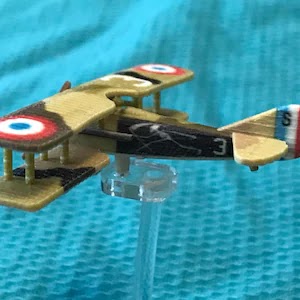1/144Reduced Aircraft Factory LLC and Shapeways pre-printed Colour 3D models
The following is a guest post from the Reduced Aircraft Factory, having seen the pre-printed 3D colour models, I thought that the wider 1/144 community would be interesting in how this was being achieved and the considerations and challenges in producing/converting exiting models. I hope you find this interesting.
If any other manufactures would like to share an insight into the methods, challenges, and innovations they encounter in the production of their products that you feel the community would be interested in please do contact me.
--- KG144
When last summer Shapeways added Mimaki full-color to their offerings, I was pretty excited. Here, at last, was a way to produce miniatures in a ready-to-use state for folks that did not have the time or materials to paint and decal 1:144 planes.
Admittedly the price was higher than I'd like: Shapeways charges $20 and then adds on for every cubic millimeter of material used.
What did not disappoint was the quality of the prints!
Surface quality: It's only when I take a photo that I really notice any stepping or uneven reflections from the 3D printed material. From a normal viewing distance the only thing you might notice is a kind of satiny sheen to the surface rather than a fully smooth specular reflection. I haven't tried sanding them because I don't know how deep the color runs. As for thinner struts and surfaces, it would probably take a new generation of Mimaki printers, or that of another manufacturer.
The gamut of colors produced is pretty wide and the precision of the colors is very fine. For instance, check out the playing cards on this Baracchini Hanriot H.D.1 print:
If you look in my shop and click on several of the selections, you'll see photos of actual prints. However, I keep the computer renders as the primary image so there is uniformity in the catalog. (I don't own a copy of every selection. Plus, I don't want to wait a few weeks for each plane to arrive before making it available.)
I've got hundreds of single-color miniatures available on Shapeways, but it takes significant work to get one of them ready for full-color printing. First, there is a one millimeter minimum size of any significant structure, whether its the thickness of a wing or tail part or strut. That is larger than other Shapeways materials, so I had to upscale many features on the models I'd already done. That is also why the struts and thicknesses look large compared to their real-life counterpart: 1mm at 1:144 corresponds to 14.4cm at 1:1 scale or about six inches, so it's as if each strut is about six inches in diameter.
The hardest part is unwrapping the plane onto a 2D texture map that determines which color will end up in which place. That's a lot like deciding how you're going to peel the surface off a globe and flatten it out to be 2D. This is something that cartographers have been struggling with for centuries. If you do it one way you get a lot of distortion in that mapping; if you do it another way you have to tear things on natural seams, which leads to less distortion but a harder time matching color changes at those seams. Here's an example texture map at reduced size:
Compared to painting and decals, there are some things I can do on a texture map much more easily. For instance, drawing a set of bands around the fuselage is very easy because they're typically just rectangles on the texture map. Other things are harder because I have to pre-distort features so that when they get mapped back onto the 3D model they will look as expected.
Some of my challenges are exactly the same as we face with conventional methods: what colors do I choose and how much weathering do I want to show? The former leads to hunting down magazines and books from the 1960s to today, Methuen Handbook of Color, and a bluetooth color sensor. I do some weathering on my models, but I typically keep it pretty modest to match the precedent of traditionally-manufactured models, which look factory-fresh.
What excites me about full-color 3D printing is that it removes many of the obstacles of inventory and distribution that would make certain models impractical using conventional methods. For instance, when Ares decides they want to produce a new model, they have to arrange for thousands of them to be manufactured in China, shipped to markets around the world, and distributed to game stores or inventoried for direct sales. There is no way they can take the financial risk or producing a plane or paint scheme that might not be a big seller. On the other hand, if I produce, say, a Sopwith Camel in George Vaughn's paint scheme and sell none, the only loss is the time I put into it. So a traditional company can afford to make 3-5 paint schemes for a Fokker D.VII available due to production and inventory challenges, I've already made 14 paint schemes available, and I'm adding more as I get time.
If I had a wish, it would be for the Shapeways base price to come down -- that would put full-color 3D prints in the reach of many more people. And today I'm limited to single-seat fighters by the pricing...I did one larger plane at 1:144 and the base Shapeways price was just too high. But it's not like I'm going to run out of paint schemes and smaller planes any time soon! Please feel free to follow up with any questions.
-- Daryl, Reduced Aircraft Factory LLC
https://www.etsy.com/shop/ReducedAircraft
https://www.facebook.com/ReducedAircraft
https://www.wingsofwar.org/forums/showthread.php?34544-Full-Color-3D-Prints-%28RAF%29











No comments:
Post a Comment